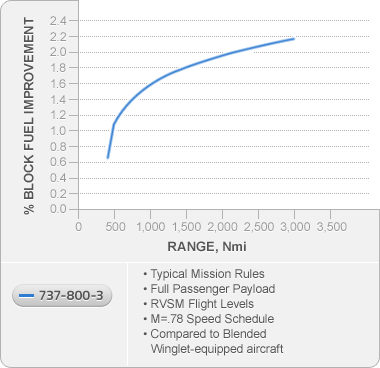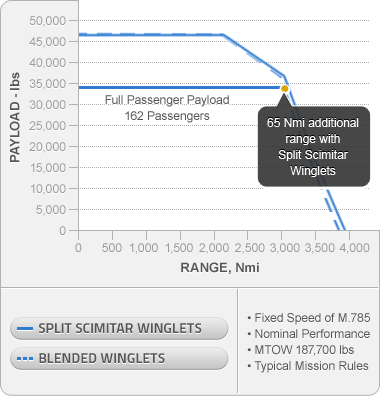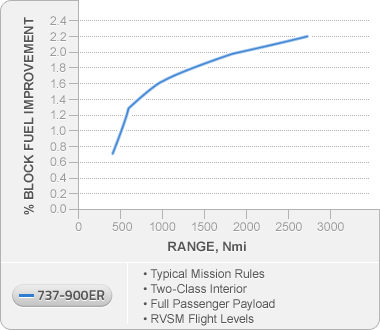Leeham News and Analysis
There's more to real news than a news release.
How the Scimitar has an advantage over winglets
Alaska Airlines is the latest carrier to order the Aviation Partners Boeing Scimitar split winglets. Here is the press release. United Airlines was the launch customer for the Scimitar.

Alaska Airlines image.
The Scimitar provides additional fuel burn savings over the blended winglet, also created by APB. The blended winglet has been retrofitted to most Boeing 737NGs, some Classics and some Boeing 757s and 767-300ERs.
Boeing has adopted a split winglet for the 737 MAX, but of its own design, which is similar in look to the APB Scimitar. APB’s cost for the Scimitar is a list price of $545,000 for the 737-800-3, a designation for the Scimitary-equipped 737-800.
Range increase in nominal over the blended winglet, according to APB.
Here are APB’s charts showing the advantage of the Scimitar over the blended winglets:
737-800-3

.

.
737-900ER

.



Does the scimitar also provide a good enough fuel saving under 1000NM, where 95% of the flights tends to be?
http://airinsight.com/wp-content/uploads/2011/08/rr-range.jpg
Depends on you route network I guess. Leisure operators / charters tend to do long flights south..
An air cishion vehicle has a skirt, so I would imagine that the lower tip provides some similar affect.
…thanks to a new performance-enhancing winglet the carrier is installing on its Boeing Next Generation 737s, which will reduce fuel consumption by 58,000 gallons a year per aircraft.
What percentage is that?
assume 8 hours flying time per day ( it is a narrowbody after all )
8 * 365 ~= 3,000 flying hours per year
58,000 gallons ~= 167,475 kg fuel
I then get 55kg fuel saved per hour .
Assuming a ballpark figure of ~3000kg fuel per hour I then get 1.8% saved.
( Looks like my math is about as bad as Alaskas math 😉
The answer is given in the block fuel burn improvement graphs that Scott posted. No additional calculations are required.
Boeings split for the Max looks like an MD11 wingtip, old and dated. The Scimitar not only looks modern, it works. Boeing should adapt it. Even the A320 “me too” winglet looks better than that ugly split thing they plan on putting on the Max.
I see you grok aerodynamics deeply 😉
The posts title imho is misleading.
The comparison is between exactly one type of winglet against one type split wingtip device.
If the scimitar tips reduce drag at the trailing tip, I’m pretty sure the next logical application would be on the tips of the vertical and horizontal stabilizers.
These surfaces operate at very low lift coefficients. In fact, the VTP does not produce any meaningful force (hence: no induced drag) and the HTP only has minimal constant lift force (positive or negative). Its size is caused by take-off rotation requirements.
Before adding funny looking devices, I would increase the aspect ratio.
The B737 would be helped most by a new wing.